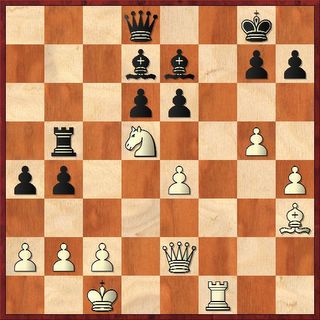2006 Michigan Class Championship, 1.15.2006
Sicilian Defense: Najdorf Varition [B99]
1.e4 c5 2.Nf3 d6 3.d4 cxd4 4.Nxd4 Nf6 5.Nc3 a6 6.Bg5 e6 7.f4 Be7 8.Qf3 Qc7 9.0-0-0 Nbd7
This was the third USCF rated game that I had played with these first 9 moves. I lost the first 2 games, both of which were played in 2005, to Randall Brooks and Derek Wilder.
10.g4 b5
This was the last book move I remembered.
11.Bg2
Bxf6 is the book move according to both MCO and NCO. Fritz scores this move similarly to the book line though.
11...Bb7 12.Bxf6 Nxf6 13.g5 Nd7
This is the same theme that is seen in the book line. After the exchange on f6, white pushes the g-pawn with a gain of tempo sending the black knight back to where it came from.
14.h4 I wanted to continue my attack and after b4 I figured I could safely defend the e4 pawn with the knight by redeploying it to g3. The other move worth consideration was a3 to prevent black's next move.
14...b4 15.Nce2 Rc8 16.Rd2
One of the benefits to developing the light squared bishop to d3 is that it makes Rd2 unnecessary.This probably isn't a bad move overall though. The 2nd rank is free of pawns on the kingside, so the rook will have some freedom to roam after Ng3 and a bishop move.
16...Nc5 17.Qe3
This move was nearly forced. If white plans to recapture on e4 with the knight, then it will be pinned to the queen.
17...Qb8
The idea here is obvious. Black plans to move the queen to a8 and put pressure down the a8-h1 diagonal. However, white will be able to prophylactically protect a third time before black even gets the queen to a8. Furthermore, white can continue protecting the pawn with his rooks.
18.Ng3 a5 19.f5
Black won't be able to take the pawn because after exf5 come exf5 with a pin of the bishop to the king. With the king still in the center and on an open file that would be a recipe for disaster.
19...Rc7 20.fxe6 fxe6 21.Bh3
After creating three pawn islands for black, white now sets his sights on attacking those weaknesses.
21...Bc8 22.Nh5?
This was clearly an error. I needed to play Rf1 before Nh5 to trap the king in the center.
22...0-0 23.Nb3 a4 Qb6
would have allowed black to achieve the same result, except that the queens would be off the board. In the current position the white queen is far better placed than the black due to her level of activity in the center of the board.
24.Nxc5 Rxc5 25.Nf4
White doubles up on the e6 pawn.
25...Re5
The only way that black can protect the pawn.
26.Nd3 Rb5 27.Nf4 Re5 28.Nd3 Rb5
Here black offered a draw, and clearly white can achieve this on the board anyhow. I only needed a draw for first place, but I had won every game in the tournament so far and I thought the black pieces did not look very coordinated or well posted. The experts and masters agreed with Fritz that black has the better position though. Even so, you never win a game by accepting a draw.
29.Rf2 Bd7 30.Rhf1 Rxf2 31.Qxf2
White has already made considerable progress. He has gained control over the f-file. Further, he now threatens the unprotected bishop on e7 with Qf7+ followed by Qxe7. 31...Qf8
At first glance the queen looks better placed on f8 than e8. The queen is purely defensive on e8, while on f8 she offers an exchange.
32.Nf4
White now prepares to ambush the black queen with a discovered attack. Qa7 is also a viable option because of the fork of the bishop on d7 and the pawn on a4.
32...Qc8??
Black perceives a threat to the e6 pawn but misses the tactics in the position. 33.Nd5!
White exposes the weakness of the f7 square. If black takes the knight with the e-pawn, then Bxe7 wins, as it forks the queen and rook. The queen cannot retake because of Qf7+ Kg8 Qf8+ Bxf8 Rxf8#
33...Qf8 34.Qe2 Qd8

35.Bxe6+!!
Not only does this remove the e-pawn attack on the d5 knight, but it checks the king. The problem is after Bxe6 come Qxb5 winning the exchange and a pawn. 1-0

No comments:
Post a Comment